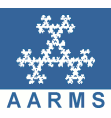 |
|
||||
Org: Shannon Sullivan (Memorial)
[PDF]
- PETER BOOTH, Memorial University
On the Classification of 3-stage Postnikov Towers [PDF] -
Moore Postnikov factorization allows us to view homotopy types of topological spaces as being constructed out of standardized building blocks, i.e., Eilenberg-MacLane spaces.
The relevant classification result has long been known for 2-stage spaces, i.e., those constructed from just two building blocks. The 3-stage case is in general unresolved.
We investigate the latter question in situations where the factorization-viewed as a fibration-has an H-cogroup base space and a product of Eilenberg-MacLane space fibres. A precise classification result up to fibrewise homotopy type is obtained for such cases.
This result appears to generalize to higher-dimensional cases in a relatively straightforward manner.
- CANAN BOZKAYA, Memorial University of Newfoundland, Department of Mathematics and Statistics
Computation of flow past a cylinder beneath of a free surface [PDF] -
This study focuses on free surface flow past a circular cylinder based on a two fluid model at a Reynolds number of R=200. The cylinder is forced to perform harmonic streamwise oscillations in the presence of an oncoming uniform flow. The effects of the free surface presence at a submergence depth of h=0.75 for a fixed Froude number, Fr =0.2 are investigated on the vortex shedding modes and fluid forces acting on the cylinder. Calculations are performed at a fixed displacement amplitude of A=0.13 in forcing frequency-to-natural shedding frequency ratio range 1.5-3.5.
- DENNIS D.A. EPPLE, University of Victoria, POBox 3060 STN CSC, Victoria, BC, V8W 3R4
The Bichromatic number of a graph [PDF] -
A (k,l)-colouring of a graph G is a covering of its vertex set by k independent sets and l cliques, generalizing both the colouring and clique covering of a graph. The bichromatic number of G is defined as the minimum integer r, such that G is (k,l)-colourable for all k+l=r. In this talk we will investigate some fundamental properties of the bichromatic number.
- KSENIYA GARASCHUK, University of Victoria, Canada
Rational decompositions of graphs [PDF] -
Given a graph G, an H-decomposition of G is a partition with its edge set into subgraphs isomorphic to H. A rational H-decomposition of G is a nonnegative rational weighting of the copies of H in G such that the total weight on any edge of G equals 1. The study of graph decompositions plays an important role in graph theory and combinatorics and has numerous applications. We will present a proof of the fact that any sufficiently large circulant (under several mild conditions) admits a rational decomposition into copies of any non-trivial graph on at most k vertices. This proof will showcase a linear algebraic connection between decomposition of these graphs and families with dominant differences.







